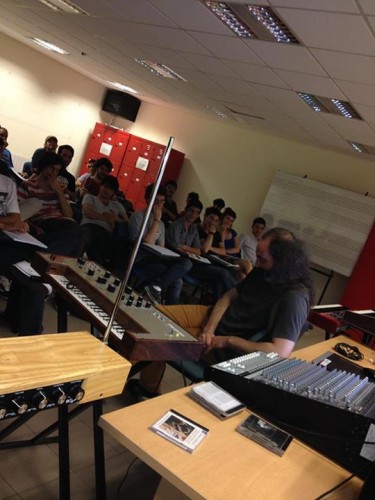Tech Talk: Therevox. June 26th
June 12th, 2014 posted by mike under Therevox News.
If you’re in the Windsor/Detroit area, I will be speaking at HackForge on June 26th at 6PM about Therevox, showing some early prototype stuff and demonstrating the ET-4.3. The event is located at the Central Branch of the Windsor Public Library, and more details can be found here.
Therevox pictures from around the world
May 17th, 2014 posted by mike under Uncategorized.Here’s some great pictures of Therevox’s being used around the world! Keep ’em coming!

Scottish band Belle & Sebastian recording at Maze Studios in Atlanta.

Music class at the Universidad Nacional de Tres de Febrero in Buenos Aires.

Canadian band The Tea Party recording at SLR Studios in Windsor Ontario.



Norwegian band Team Me performing at SXSW 2014 in Texas.
Video and Interview with Therevox player Mark Calcott
February 19th, 2014 posted by mike under Artist Profiles, Videos.In this video, Mark plays a 4-part Bach Chorale using his Therevox ET-4 for every voice. We got to ask mark a few questions recently about his gear.
Therevox: As someone who has lugged a Hammond and Leslie to a gig, can you explain the importance of playing the “real-deal”?
Mark Calcott: There’s something special about playing the real thing. You can feel the richness and warmth of the sound shake your whole body. Even though it’s an electric instrument, the sound is very organic. Go play a 9′ Steinway for a little bit, and then try to tell me that your software piano is the same thing. It’s not. The experience of hearing, and feeling those long strings resonating right in front of you is part of the experience of the a real instrument. The same thing goes for the harpsichord. You feel the strings vibrate in a different way than you do coming from a set of speakers. The action of the harpsichord is also very important too. You can feel the resistance of the plectra beneath your fingers on the real instrument.
You recently acquired a Harpsichord in Detroit, any other interesting gear acquisition stories?
Man, I love Detroit for odds and ends like that. I bought that harpsichord for $225, and brought it back home in my station wagon. About 2 years ago I found someone who was selling an Optigan for $100.When I went to test it out, it lit up, but barely made a sound. I ended up getting it for $20. When I brought it home, I let it warm up for a bit, and it started working for me! Most recently, although not a cool keyboard, I acquired an original 1980/81 “Gorf” arcade.
What are some of the instruments you find yourself going back to often and why?
Piano, and organ. Particularly, the sound of the Hammond organ. I recently sold my Roland Fantom G6 to offset the cost of a Nord C2D. I use the Nord in place of my old ‘brass’ or ‘wind’ instrument samples. It just sounds better.
You have been playing Therevox for over a year now, can you talk a bit about the learning curve or maybe share some pointers?
When I had to learn Good Vibrations, I remember having to practice my octave jumps many times. Since then I have noticed that any big jump over a 3rd or so, is going to require some rehearsing, if you want to land on your note consistently every time. Make sure you are actively listening. It’s very easy, and irritating, to be just a little out of tune!
Where does your Therevox ET-4 fit in to the music you make?
So far, I’ve been using the Therevox mainly for my own relaxation. I like to zone out with it, and explore its sounds when I’m feeling stressed. It’s just so expressive, and pulls you in, that you forget about life for a while. I’ve used it on a few gigs, one of which had me playing the obligatory Good Vibrations lick. It was a lot of fun. I’ve also used once with Huladog. Mainly though, it is a studio instrument for me.
What musical projects are you currently working on?
ome of the projects currently keeping me busy are The Funk Junkies,
the Bad Mothers, Dream Catcher, Huladog and James Gibb.
New Therevox Expression Pedal
January 24th, 2014 posted by mike under Therevox News.This one has been on the back-burner for a while, and I’m happy to say that it is finally done! When we designed the ET-4, we always expected would be used with an expression pedal full control of the sound (pitch, amplitude and timbre). While most off-the-shelf expression pedals will work fine, we designed this pedal to be a perfect complement to the instrument. Included is a 5′ cable that we’ve made using high quality jacks and vintage reproduction cotton overbraid cord.


For more information, see the product page, and youtube video.
From our facebook page
January 10th, 2014 posted by mike under Workshop Updates.If you aren’t following our facebook page, here are some photos that we’ve recently posted from the shop.







